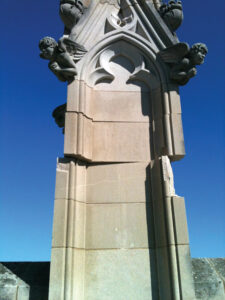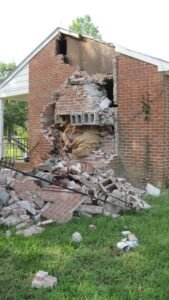
Ten-year anniversary of the 2011 Virginia earthquake: the most widely felt earthquake to rock the Eastern U.S.

![]() Ten years ago this month, on Aug. 23, 2011, a magnitude 5.8 earthquake struck the Piedmont region of the U.S. state of Virginia at 1:51 p.m. EDT from a depth of four miles below the Earth’s surface. The epicenter of the quake in Louisa County, was 38 miles northwest of Richmond and about five miles south-southwest of the town of Mineral, Virginia. While the quake lasted less than a minute, the seismic event caused damage to buildings, including important historical sites such as the Washington National Cathedral and the National Washington Monument, and rattled the citizens along the Eastern seaboard who are unaccustomed to tremors.
Ten years ago this month, on Aug. 23, 2011, a magnitude 5.8 earthquake struck the Piedmont region of the U.S. state of Virginia at 1:51 p.m. EDT from a depth of four miles below the Earth’s surface. The epicenter of the quake in Louisa County, was 38 miles northwest of Richmond and about five miles south-southwest of the town of Mineral, Virginia. While the quake lasted less than a minute, the seismic event caused damage to buildings, including important historical sites such as the Washington National Cathedral and the National Washington Monument, and rattled the citizens along the Eastern seaboard who are unaccustomed to tremors.
The strongest recorded earthquake east of the Rocky Mountains since 1944 and the strongest ever recorded in central Virginia’s seismic zone, it’s believed that the quake could be felt from as far south as Atlanta, Georgia, to as far north as Quebec City, Quebec, Canada — making it the most widely felt seismic event in North America’s history with approximately one-third of the U.S. population reporting that they felt movement. Numerous aftershocks, ranging up to 4.5 in magnitude, occurred after the main tremor and were felt as far away as New England, Georgia and Illinois.
The earthquake caused widespread minor and moderate damage to buildings — damage was reported as far away as Brooklyn, New York — as well as minor to major damage to almost 600 residential properties. No deaths were reported, and the only known injuries were minor. The total economic losses from the earthquake were about $200 to $300 million.
Damage to structures
Much of the structural damage was confined to brick buildings and unreinforced masonry structures, according to the U.S. Geological Survey. Several team members with the Earthquake Engineering Research Institute, a leading technical society in dissemination of earthquake risk and earthquake engineering research, visited Mineral (the town closest to the epicenter), Louisa City and other areas in Louisa County three and four days after the earthquake. They observed minor to moderate damage to unreinforced masonry homes and schools, failure of brick veneer, minor cracking in reinforced masonry and reinforced concrete structures, and failure of some residential carport structures. Post-event building inspections were also conducted by approximately 12 inspectors that included Louisa County building inspectors as well as inspectors on loan from jurisdictions around Virginia.

The town of Mineral reported the collapse of two buildings, as well as minor damage to several other structures, including the collapse of the ceiling in its town hall. Fallen chimneys and other structural damage to buildings were also reported in Louisa City. Two historic unreinforced masonry buildings in the area were moderately damaged. The water tower, across from the county courthouse, looked like it had been there at least 50 years, but the anchor bolts showed no movement or stretching. There was no damage to the courthouse or to the historic jail next to the courthouse.
The Gilboa Christian Church, built in Cuckoo in 1832, had considerable architectural and some structural damage and was rendered unusable. The outer wythe of a brick wall collapsed where there was no apparent connection between the wythes of the wall, a portion of a gable wall collapsed that did not appear to be well anchored to the roof diaphragm, and a section of brick veneer also failed where ties between the brick and backup wall consisted of 16d nails driven into straight sheathing and then encased in the brick mortar joint. Additionally, approximately 20 percent of the vertical standing tombstones in the Gilboa Church cemetery were thrown over.
The Cuckoo House, a federal-style house built in Cuckoo in 1819, was an unreinforced masonry building that sustained considerable architectural and some structural damage with the partial collapse of some walls and both tall chimneys.
At the Louisa County High School, cinderblocks fell in classrooms, and cracks were seen in walls. Louisa County schools were closed while engineers assessed damage to school buildings. The high school and Thomas Jefferson Elementary were closed for the remainder of the school year. Inspections revealed that 65 homes sustained major or severe damage and 125 homes experienced mild to moderate damage.
Several buildings in Culpeper, about 37 miles north of the epicenter, sustained structural damage. The brick façade of the Levy Building, built during 1848, collapsed and the building was condemned and demolished. The walls of St. Stephen’s Episcopal Church, constructed during 1821, buckled and were deemed unstable by town officials. Another church, Culpeper Baptist Church, built during 1894, lost its chimney. And in Fredericksburg, about 37 miles northeast of the epicenter, the Dickinson Building on the campus of Germanna Community College was deemed unusable for the rest of the semester, and the whole college was closed until alternative classrooms could be found.
In Arlington County, the Robert E. Lee Memorial (in Arlington National Cemetery) experienced significant damage when the quake shifted the structure’s back wall by a quarter of an inch, producing large cracks in the plaster and requiring the closure of the House’s back hallway and second floor. The County’s Thomas Jefferson Theater closed for several months due to damage to its stage area, including a shift of the masonry bearing walls and supports for its fly gallery and gridiron deck. The nearby city of Alexandria experienced damage to chimneys and other brickwork in Gadsby’s Tavern, the Alexandria City Hall and other historic buildings.
Moving forward
The 2011 Virginia earthquake was an intraplate earthquake with a maximum perceived intensity of VII (very strong) on the Mercalli intensity scale and occurred in a hot spot for quakes known as the Virginia Seismic Zone. Although earthquakes in the central and eastern U.S. are substantially less frequent than in the western U.S., they are typically felt over a much broader region. East of the Rocky Mountains, an earthquake can be felt over an area as much as 10 times larger than a similar magnitude earthquake on the west coast. Western rock is relatively young; therefore, it absorbs much of the shaking caused by earthquakes. So, while western earthquakes result in intense shaking close to the epicenter, they fade more quickly the farther the earthquakes travel. In the eastern U.S., the rock is much older, and earthquake energy can therefore spread farther and have a greater impact.
While earthquakes in this region occur less frequently than other natural hazards such as severe storms and floods, the impact of a large earthquake could equal or exceed the damage inflicted by other natural disasters. Most historic engineered structures located in the densely populated corridor along the Atlantic coast between Boston and Washington, D.C., were not designed against earthquake loading and, although the anticipated shaking intensities are moderate compared to more seismically active areas in the western United States, the density and high monetary value of East Coast structures puts them at considerable risk to costly earthquake damage. The Virginia quake is a noteworthy reminder that communities on the East Coast are not prepared to cope with a major earthquake, and that steps could be taken to improve their readiness and increase loss reduction efforts.
Today, the state of Virginia does very well in terms of building safety, ranking second in the U.S. for strong building codes and licensed, certified and educated contractors in the recently released 2021 edition of Rating the States, which is published every three years by the Insurance Institute for Business & Home Safety (IBHS). The report finds that most states with strong building code systems in place and that have maintained effective enforcement systems remain committed to building safety. “It’s nice to see that there are jurisdictions like Virginia that take codes seriously, because codes are about life safety,” said IBHS President and Chief Executive Officer Julie Rochman.
Many jurisdictions within the state are also committed to improving their resiliency and setting the standard for other communities to follow. The city of Martinsville was awarded an “essential” designation for its building-related activities and an “enhanced” designation for its housing-related initiative last month from the Alliance for National & Community Resilience (ANCR). Martinsville was selected as the initial pilot city for ANCR’s Community Resilience Benchmarks (CRB) for buildings and housing. “We were particularly impressed with the involvement of city staff and their transparency and thoroughness as we worked through the benchmarking process. Their commitment to the process will be invaluable in supporting improvements in the CRB process and help enhance the resilience of other communities,” said Evan Reis, ANCR board chair and executive director of the U.S. Resiliency Council.
Further north, Arlington County is committed to ensuring the safety and sustainability of structures for residents, workers, and visitors. The Arlington County Code Enforcement Section of the Inspection Services Division is the first property maintenance enforcement agency in Virginia to obtain accreditation from the International Accreditation Services (IAS). This designation is critical to accomplishing the Inspection Services’ mission to provide the highest quality of public service and building safety while ensuring compliance with the Virginia Uniform Statewide Building Code and other applicable local codes and ordinances.






